1. Choose a Suitable Site
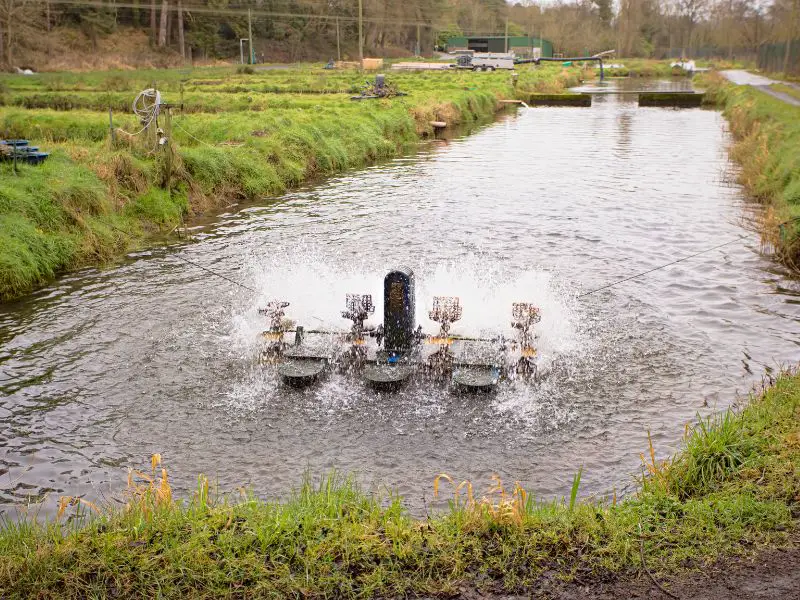
- Water quality: The site should have access to clean, fresh water with a consistent temperature. Water quality is important for the health and well-being of the trout, so it is important to regularly test the water for pH, oxygen levels, and other indicators of water quality.
- Water supply: There should be a reliable source of water available to maintain the required volume of water in the tanks or ponds. This could be a natural water source, such as a stream or river, or an artificial system, such as a well or water treatment plant.
- Water temperature: Trout prefer a consistent water temperature, typically between 50 and 60 degrees Fahrenheit. If the water temperature fluctuates significantly, it can be stressful for the fish and affect their growth and survival rates.
- Space: The site should have enough space to accommodate the number of trout you plan to raise. This will depend on the size of the tanks or ponds and the density of the fish.
- Access to markets: It is important to consider the location of the site in relation to potential markets for your trout. If you plan to sell the fish, you will need to be able to transport them to customers efficiently.
- Permits and regulations: Check with local authorities to determine any permits or regulations that may be required for trout farming in your area.
2. Set Up Infrastructure
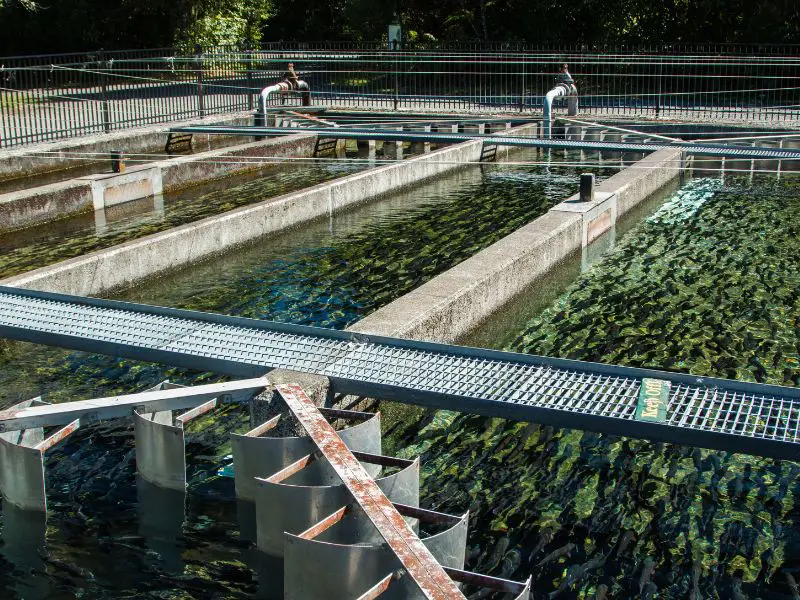
To raise trout, you will need to set up the appropriate infrastructure to house and care for the fish. This may include tanks, raceways, or ponds. The specific type of infrastructure you choose will depend on the size and scale of your operation, as well as the specific needs of the trout.
Tanks: Trout can be raised in tanks, which can be made of concrete, plastic, or other materials. Tanks can be used for hatcheries, where eggs are incubated and fry are raised, or for grow-out, where the fish are raised to a larger size.
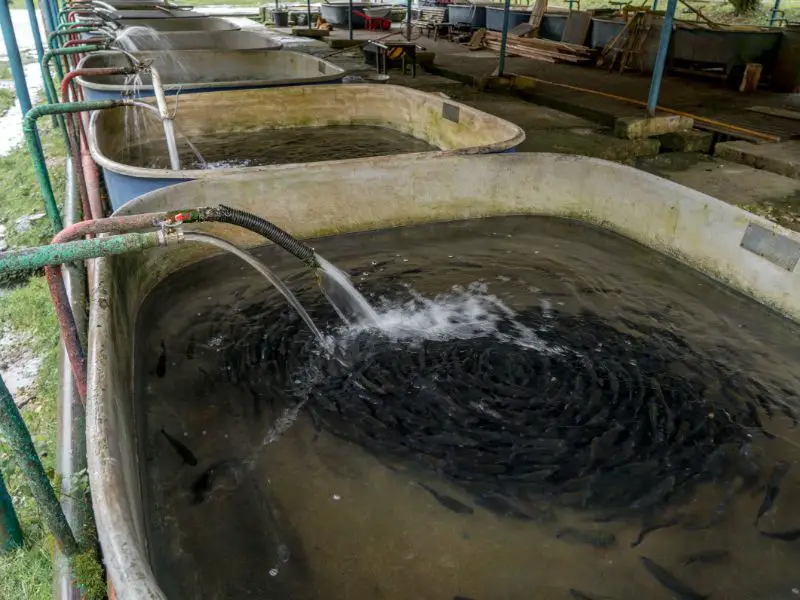
Raceways: Raceways are long, narrow channels that are used to raise trout. Water is circulated through the raceway, providing oxygen and nutrients to the fish. Raceways can be used for hatcheries or grow-out, and are often used in conjunction with tanks.
Ponds: Ponds can be used to raise trout, although they may be more susceptible to predation and diseases. Ponds should be designed to provide a healthy environment for the fish, with adequate space and water circulation.
In addition to the tanks, raceways, or ponds, you will also need to set up a system to provide clean water and maintain water quality. This may include filters, aeration systems, and pumps.
In general, it is recommended to provide at least 10-20 gallons of water per pound of trout, although this can vary depending on the specific conditions of the farm.
For example, if you are raising 1,000 pounds of trout in a tank that is 10 feet long, 6 feet wide, and 4 feet deep, you will need at least 10,000-20,000 gallons of water to provide sufficient space and water quality for the fish.
Carefully design and maintain the infrastructure to ensure the health and well-being of the trout. Proper infrastructure helps reduce stress on the fish and improve their growth and survival rates.
3. Obtain Trout Eggs or Fry
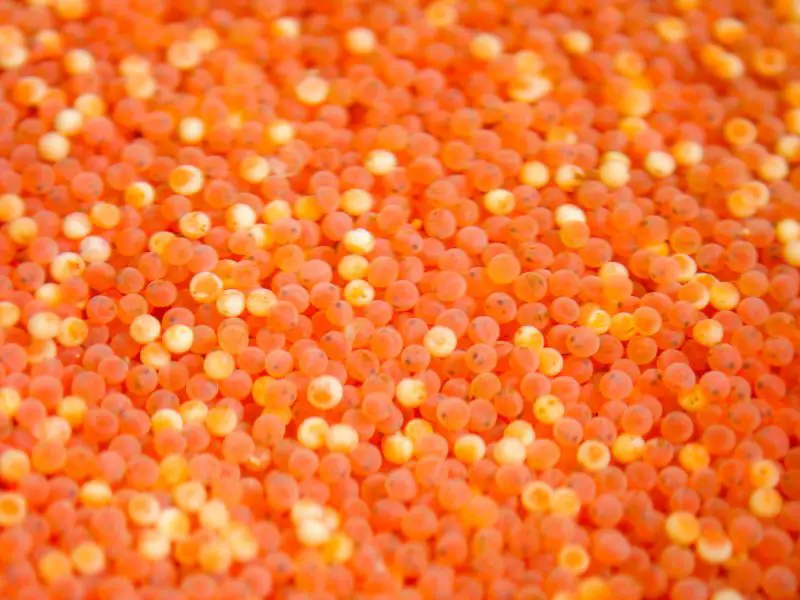
There are a few different ways to obtain trout eggs or fry:
- Purchase them from a hatchery or fish farm: Many hatcheries and fish farms raise trout and sell eggs or fry to be used for stocking ponds or streams. These eggs or fry can be purchased from the hatchery or farm directly.
- Collect eggs from wild trout: If you have a stream or river with wild trout, you may be able to collect eggs from these fish during the spawning season. This is typically done by gently squeezing the abdomen of a female trout while it is still in the water. The eggs can then be collected and used to hatch fry.
- Raise trout from eggs in a hatchery: If you have access to a hatchery, you can also raise your own trout from eggs. This process involves incubating the eggs in a hatchery until they hatch into fry, and then raising the fry until they are large enough to be released into a pond or stream.
Follow all applicable laws and regulations when collecting or raising trout eggs or fry. In many areas, it is illegal to collect eggs or fry from wild trout or to release domesticated trout into the wild.
4. Incubate and Hatch the Eggs
To incubate and hatch trout eggs, you need a hatchery or incubation system. Here are the general steps for incubating and hatching trout eggs:
- Collect the eggs: Depending on the method you are using to obtain the eggs, you may need to collect them from wild trout or purchase them from a hatchery or fish farm.
- Clean and disinfect the eggs: It is important to clean and disinfect the eggs to reduce the risk of infection or disease. This can be done by gently rinsing the eggs with clean water and then dipping them in a solution of water and disinfectant.
- Place the eggs in an incubation tray: Once the eggs are clean and disinfected, they can be placed in an incubation tray or hatching jar. Make sure to gently place the eggs in the tray or jar so that they are not damaged.
- Incubate the eggs: The eggs will need to be kept in a cool, dark place with a constant temperature of around 50-55°F (10-13°C). They will also need to be kept moist, so make sure to regularly add water to the tray or jar to keep the eggs hydrated.
- Monitor the eggs: Check on the eggs regularly to make sure they are developing properly. As the eggs near hatching, you may notice that the eggs become transparent and you can see the fry developing inside.
- Hatch the eggs: When the eggs are ready to hatch, the fry will emerge from the eggs. At this point, you can carefully transfer the fry to a separate tank or container to continue raising them.
Remember to maintain proper water quality and temperature during the incubation and hatching process to ensure that the eggs and fry develop properly.
If you’re having difficulty incubating and hatching the eggs, consider seeking the advice of a professional hatchery or aquaculture specialist.
5. Raise the Fry
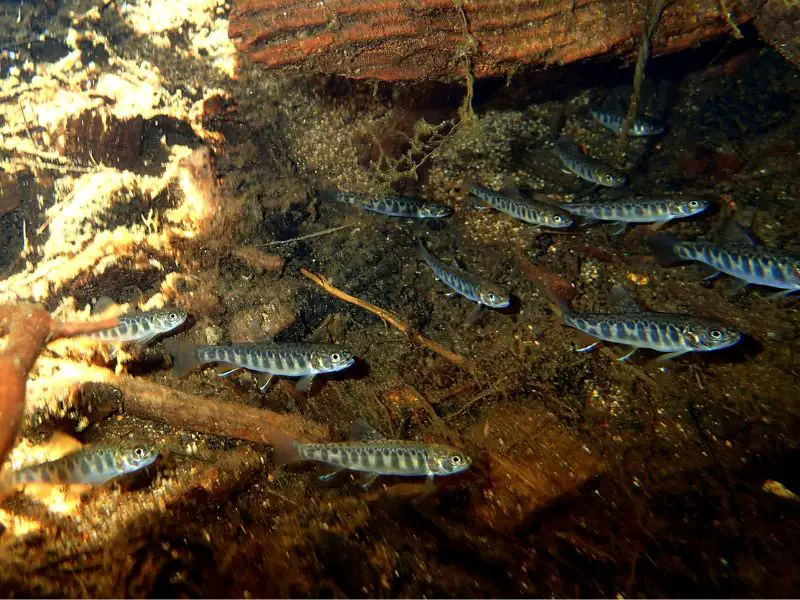
Raising trout fry requires a clean, well-maintained tank or pond with good water quality and appropriate temperature and oxygen levels. Here are the general steps for raising trout fry:
- Set up a tank or pond: Choose a tank or pond that is appropriate for the size and number of fry you will be raising. Make sure to properly clean and disinfect the tank or pond before introducing the fry.
- Acclimate the fry: Slowly acclimate the fry to the tank or pond by gradually introducing them to the water over the course of an hour or two. This will help prevent shock and allow the fry to adjust to their new environment.
- Maintain proper water quality: Keep the water clean and well-oxygenated by regularly performing water changes and using a filter. Test the water regularly to ensure that the pH, temperature, and other parameters are within appropriate ranges for trout.
- Feed the fry: Fry will need to be fed small amounts of food several times a day. Use a high-quality fry food or a finely ground version of a pellet or flake food.
- Monitor the fry: Check on the fry regularly to ensure that they are healthy and growing properly. Look for signs of stress or illness, such as lethargy or abnormal behavior, and take appropriate action if necessary.
- Gradually increase the size of the tank or pond: As the fry grow, you will need to gradually increase the size of the tank or pond to accommodate their growing size and needs.
Raising trout fry can be a rewarding and enjoyable hobby, but be patient and attentive to the needs of the fry to ensure their health and well-being. As mentioned before, if you’re having difficulty raising the fry, consider seeking the advice of a professional hatchery or aquaculture specialist.
6. Feed the Trout
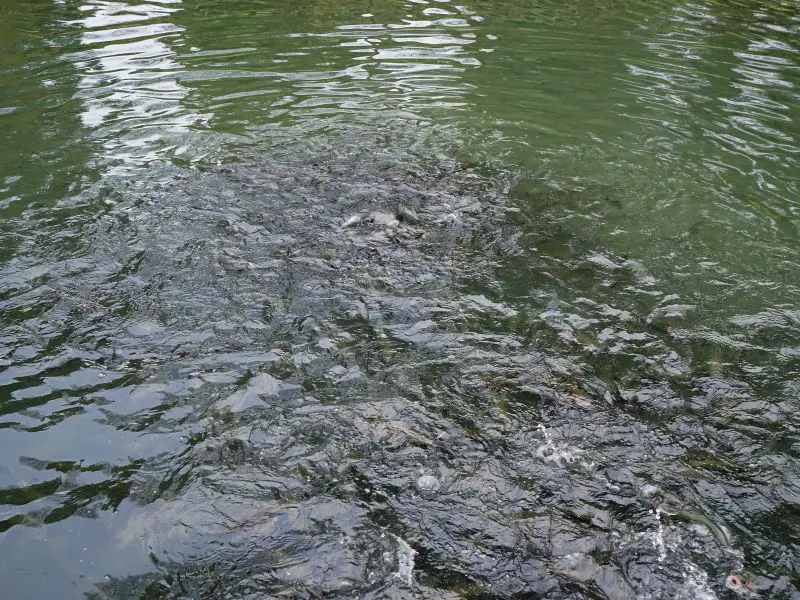
What to Feed Trout
Here is a list of some common foods that can be fed to trout in a trout farm:
- Pellets: Pellets are a convenient and widely available type of feed that can be used to provide a balanced diet for trout. They are typically made from a mixture of grains, fish meal, and other ingredients.
- Flakes: Flakes are another common type of feed that can be used to feed trout. They are typically made from a mixture of fish meal, grains, and other ingredients and are available in a variety of formulations to meet the needs of different life stages and species.
- Brine shrimp: Brine shrimp are a type of small, planktonic crustacean that can be fed to trout as a supplement to their diet. They are high in protein and can be purchased live or as a freeze-dried product.
- Daphnia: Daphnia are a type of small, planktonic crustacean that can also be fed to trout as a supplement to their diet. They are high in protein and can be purchased live or as a freeze-dried product.
- Worms: Earthworms and other worms can be fed to trout as a supplement to their diet. They are high in protein and can be purchased from a bait shop or collected from the wild.
- Vegetables: Some trout will also accept vegetables as a part of their diet. Examples include lettuce, spinach, peas, and other leafy greens.
Provide a varied and nutritionally balanced diet to ensure that the trout receive all of the nutrients they need to grow and stay healthy.
Also, monitor the feeding habits of the trout and adjust the amount and frequency of feeding as needed to ensure that the trout are receiving the proper nutrients and are not overfed.
How to Feed Trout
There are a few different ways to feed trout in a trout farm:
- Use a feeding machine or automatic feeder: Many trout farms use feeding machines or automatic feeders to dispense food to the trout on a regular schedule. These devices can be programmed to dispense the appropriate amount of food at specific intervals throughout the day.
- Hand-feed the trout: In smaller operations, it may be more practical to hand-feed the trout. This can be done by scattering the food on the surface of the water or by using a feeding stick or scoop to place the food in specific areas of the tank or pond.
- Use a feeding tray or feeding ring: Some farms use feeding trays or feeding rings to contain the food and prevent it from being scattered throughout the tank or pond. This can help to reduce waste and ensure that the trout have access to the food.
Regardless of the method you choose, it’s important to use a high-quality, nutritionally balanced feed that is appropriate for the size and age of the trout.
Also, monitor the feeding habits of the trout and adjust the amount and frequency of feeding as needed to ensure that the trout are receiving the proper nutrients and are not overfed.
7. Monitor and Maintain Water Quality
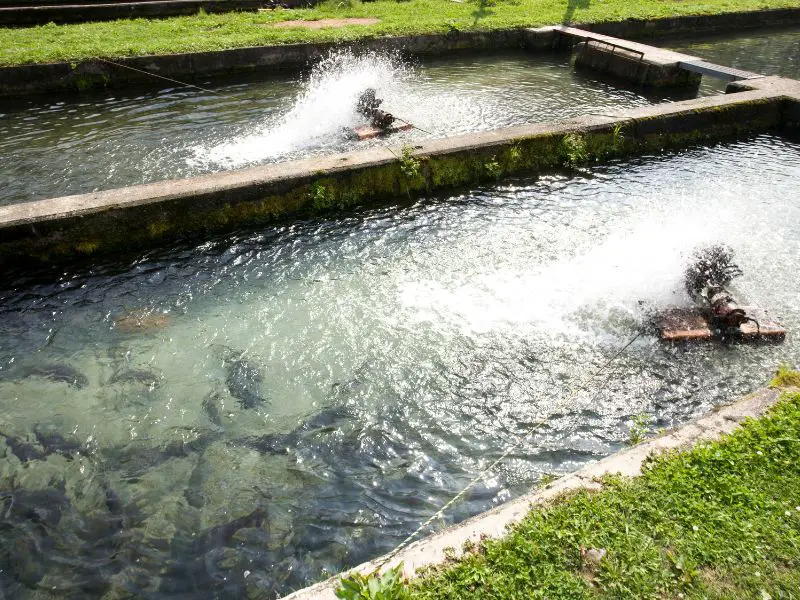
- Regularly test the pH, temperature, and dissolved oxygen levels in the water. Trout require a pH of 6.5-7.5, water temperature of 55-65°F, and dissolved oxygen levels of at least 6 mg/L.
- Use a biological filtration system to remove excess nutrients and organic matter from the water.
- Keep the water well-aerated to maintain proper dissolved oxygen levels.
- Monitor the levels of ammonia, nitrite, and nitrate in the water. High levels of these substances can be toxic to trout.
- Use a water conditioner to remove chlorine and chloramines from the water, as these chemicals can be harmful to fish.
- Regularly clean the tanks and equipment to prevent the buildup of algae and other contaminants.
- Quarantine new fish before introducing them to the main population to prevent the spread of disease.
8. Harvest the Trout
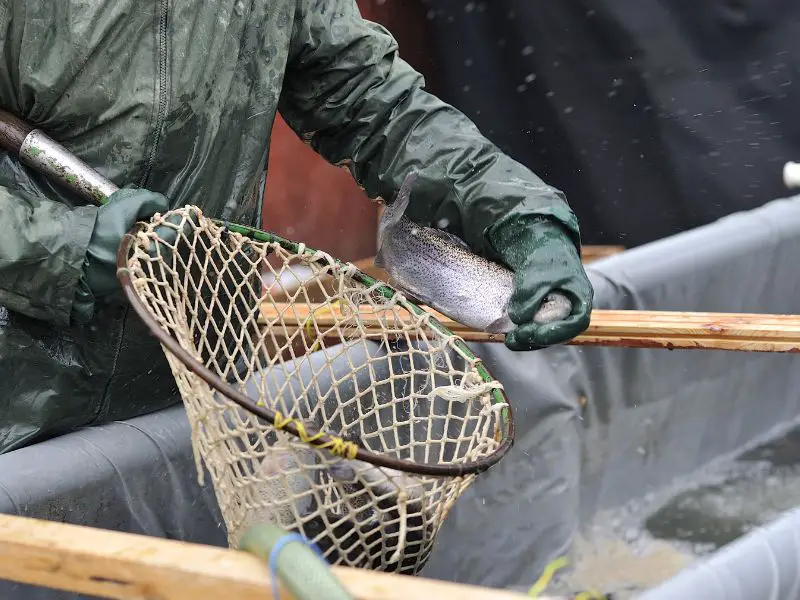
- Netting: This involves using a net to catch the fish as they swim through a narrow channel or passageway.
- Seining: This method involves using a large net to encircle the fish and then slowly pulling it through the water to capture the fish.
- Drain and sort: In this method, the water is drained from the tanks or ponds and the fish are sorted by hand.
- Electrofishing: This involves using an electric current to stun the fish, which allows them to be easily collected.
Once the fish have been harvested, they should be handled carefully to minimize stress and damage. Carefully place the trout in a holding tank or on ice until they can be processed or transported to market.
It’s best to manage the harvest process as carefully as possible to ensure that the fish are handled humanely and are of the highest quality when they reach the market.
How Long Does it Take Trout to Grow?
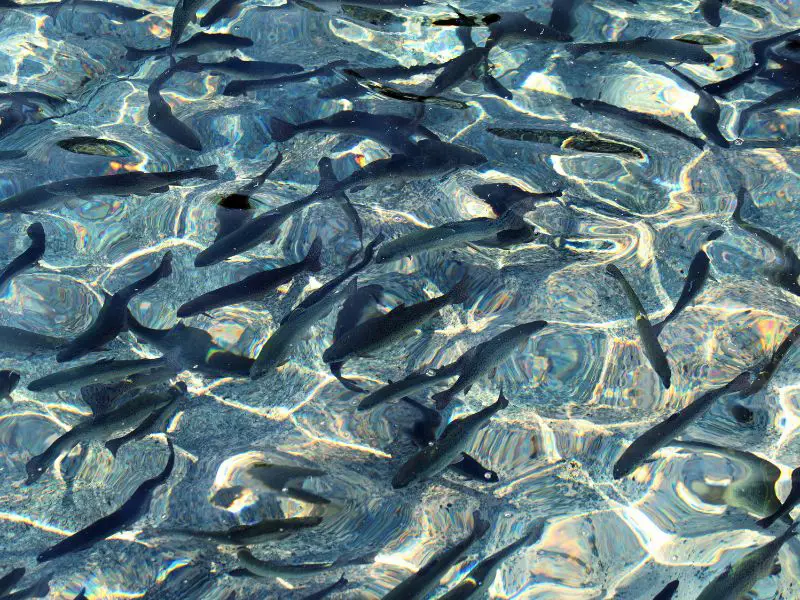
In a trout farm, it is common for the fish to be harvested at a smaller size, typically around one pound, although some farms may raise the fish to a larger size before harvesting.
Trout grow relatively quickly, especially in the first year of life. Some species of trout, such as rainbow trout, can grow up to a pound or more in their first year of life under ideal conditions. Other species, such as brook trout, may grow more slowly.
The amount of time it takes for a trout to grow in a trout farm depends on the species of trout, the size of the fish at the time of stocking, the water temperature and quality, the availability of food, and the stocking density.
How Big of a Pond Do Trout Need?
In general, a pond that is at least 0.5 acres in size is suitable for raising trout. However, larger ponds will be able to support more fish and may be more efficient to operate.
Remember, the size of the pond is not the only factor to consider when raising trout. Other factors, such as water quality, temperature, and dissolved oxygen levels, also need to be taken into account.
